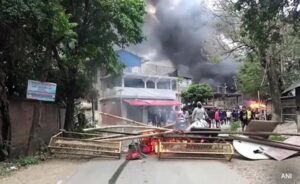(This article was first published in The Wire on 2 January 2018.)
Two hundred years ago, the last battle of the Anglo-Maratha war was fought at Koregaon village on the banks of Bhima river near Pune. The battle marked the firm hold of the British Empire in India. The British erected an obelisk at the battle ground in the memory of the dead. It has 49 names, 22 of them are identified by their ‘nak’ suffix as Mahars. It was construed as the testimony to the gallantry of Mahar soldiers, and was rightly used by the first batch of Mahar leaders such as Gopal Baba Walangkar, Shivram Janba Kamble and even Ramji Ambedkar, B.R. Ambedkar’s father, when pleading the British for the restoration of Mahar recruitment in the British army when it was stopped in 1893. The stoppage of Mahar recruitment was a consequence of the Indian uprising of 1857, after which the British reassessed their recruiting strategies to include only those from ‘martial races’ in the army.
But when Babasaheb Ambedkar painted the Battle of Bhima Koregaon as the battle of Mahar soldiers against their caste oppression in Peshwa rule, he was creating a pure myth. As myths are required to build movements, he perhaps saw its necessity then. But after a century, when it solidifies into a quasi-history and tends to push Dalits deeper into an identitarian marshland, it should become a worrisome matter. Many Dalit organisations recently formed a joint front to observe the 200th anniversary of this battle as a campaign to launch an attack on the new Peshwai, the rising Brahmanic rule of the Hindutva forces. Their long marches culminated into an Elgar Parishad (conference) at the Shaniwarwada at Pune on December 31. While the resolve to fight the Hindutva forces is certainly laudable, the myth used for the purpose may be grossly counterproductive insofar as it reinforces identitarian tendencies whereas the necessity is to transcend them.
As regards history, it is a fact that when the East India Company developed its military aspirations, it recruited Dalits in disproportionately large numbers, perhaps for their unflinching loyalty and faithfulness and also because they were cheaply available. One finds disproportionate numbers of the Namshudras in Bengal, the Parayas in Madras and the Mahars in Maharashtra in its army. If the Dalits wanted to claim significant contribution to the establishment of the British Raj in India, it may not be as such incorrect. But to attribute motive of fighting caste oppression to their soldiery shall be far-fetched and unhistorical.
The East India Company fought and won several battles from the first one in Plassey in 1757 before the last battle of the Anglo-Maratha war. Obviously, all of them were not against the Peshwas. Most of them were not even against the Hindus. They were simply wars between the two ruling powers, which their soldiers fought just as their duty. To make them appear as anti-caste or anti-religion will not only be factually incorrect, but also an erroneous understanding of historical caste. Caste, until after the late 19th century when there was a substantial spread of education among the Dalits, has been the life-world of people. They took caste as a natural order and their oppression as the fate that they had to meekly endure. Therefore, there was no question of any resistance to caste, leave apart physical war against them. Contrary to such myths of bravery, there is no evidence of any militant resistance the Dalits ever posed against the Brahmanic oppression.
With regard to formation of warring armies, they were not purely composed on communal lines. While the Dalit soldiers may be relatively in large numbers in British army, it is not that they did not exist in Muslim or Maratha armies. As with communities, all castes existed in all the armies. In the Battle of Koregaon, one of the three wings of the Peshawa infantry was Arabs, which had reportedly fought most fiercely and had most casualties. What could be their motivation? Did they want the Peshwa’s Brahmanic rule to triumph? The fact is that they simply fought as soldiers for their masters, as the Dalits did for theirs. It would be grossly erroneous to attribute loftier motives to them than this.
Before the battle of Koregaon on January 1, 1818, the Peshwas had been reduced to weaklings by the earlier two Anglo-Maratha wars. As a matter of fact, the Peshwa Bajirao II had fled Pune and was attempting to attack Pune from outside. Peshwa’s army comprised 20,000 cavalry and 8,000 infantry, out of which around 2,000 men, divided into three infantry parties each comprising 600 Arabs, Gosains and soldiers, mounted the attack. The majority of the attackers were Arabs, reputed to be the finest among the Peshwa soldiers. The Company troops comprised 834 men, including around 500 soldiers of the 2nd Battalion of the 1st Regiment of Bombay Native Infantry, which was manned predominantly by Mahar soldiers. Although there is no record of their exact number, it is obvious that all of them were not Mahars. Even going by the casualties, the majority of those died in the battle (27 out of 49) were not Mahars. The Peshwa army ultimately withdrew, fearing the arrival of a larger British force led by General Joseph Smith. In view of these factual details, it may be misleading to portray the battle as Mahars’ vengeance against the Peshwas’ Brahmanic rule.
There is no evidence that after the defeat of Peshwai, there was any relief that accrued to Mahars. As a matter of fact, their caste oppression continued unabated. Rather, as hinted earlier, the ungrateful British stopped their recruitment to the army, refusing to acknowledge their past bravery. They ignored their pleas to restore recruitment until threatened by the First World War, in the wake of which they restarted their recruitment. There is no dispute that the British colonial rule brought Dalits numerous benefits, to the extent that the very birth of the Dalit movement may be attributable to it. But it must simultaneously be understood that it was unintended and primarily dictated by their colonial logic. It is unfortunate that Dalits blind themselves to this reality with their identity blinkers.
It is equally incorrect to say that since the Peshwa forces belonged to the Maratha confederacy, they were the nationalist forces, and the defeating British forces were the imperialists. To see historical facts through the spectacles of a non-existent nation is equally condemnable. There was no concept of an Indian nation; as a matter of fact, this concept eludes us even to this day. Paradoxically, India itself is by and large a gift of British rule, having forged a political unity of vast landmass of the subcontinent. Those who have been driving it as a nation for their selfish gains are indeed debauched like Peshwas and are the biggest anti-nationals.
The Dalits do need to fight this new Peshwai recreated by the Hindutva marauders. For that, they better open their eyes to see the reality, rather than an ostrich-like look into the mythical past and imagine their greatness.
(Courtesy: The Wire.)
[This article published in The Wire generated considerable controversy. Prof Teltumbde did not have an occasion to respond to the allegations made against him, due to his entrapment in the Elgar Parishad case. He recently wrote a note, “Anand Teltumbde Explains the Genesis of His Articles on Bhima-Koregaon” that has been published in ‘The Wire’, explaining the factual background and motive for his writing the above article. Below, we give an extract from this article.]
What is it to be Ambedkarite?
Though I received quite a few congratulatory messages, my detractors had a field day. They created a chorus that I was anti-Ambedkar or that I insulted Babasaheb Ambedkar by calling Bhima-Koregaon a myth. None refuted the facts I had mentioned or touched the theme of the article. Instead, they reveled in suicidal irrationality, ignorance and abuse – all un-Ambedkarite depravities.
Babasaheb Ambedkar expected his disciples to be prabuddha (enlightened), which is much more than being educated and being able to scribble nonsense on WhatApp or Facebook. As for the meaning of following Babasaheb Ambedkar, these worthies should read his Ranade, Gandhi and Jinnah wherein, more than any of his contemporaries, he elucidated the relationship between the master and disciple. I know they would never read it in original and hence give here the requisite extract from it to open their eyes:
All Liberals I know will say our duty is to follow the master. What else could be the attitude of a devout band of disciples? It means that a great man works by imposing his maxims on his disciples. It means that the disciples should not be wiser than the master. Both these conclusions are wrong. They do injustice to the master. No great man really does his work by crippling his disciple by forcing on them his maxims or his conclusions. What a great man does is not to impose his maxims on his disciples. What he does is to evoke them, to awaken them to a vigorous and various exertion of their faculties. Again the pupil only takes his guidance from his master. He is not bound to accept his master’s conclusions. There is no ingratitude in the disciple not accepting the maxims or the conclusions of his master. For even when he rejects them he is bound to acknowledge to his master in deep reverence “You awakened me to be myself: for that I thank you.” The master is not entitled to less. The disciple is not bound to give more. [Babasaheb Ambedkar, Writings and Speeches, Vol. 1, p. 240 (Govt. of Maharashtra)]
A sincere Ambedkarite would be disturbed seeing the pathetic condition of Dalits, and of the institutions Babasaheb established and left behind. He would invest his or her intellectual energy to addressing what went wrong and not promote a devotional cult which Ambedkar detested. They would be able to see that what I have been doing is the former – analysing the past and trying to contribute to strategies for future, and not showing off my scholarship for any gain whatsoever, unlike most others.
While this is what a true follower of Ambedkar ought to be doing, many are doing the latter – promoting a devotional cult of Ambedkar, hollowing out his radical content and helping the ruling classes exploit his legacy. This is precisely what his followers ought not to be doing. In terms of Babasaheb Ambedkar’s assessment in the above quotation, all those engaged in shouting ‘Ambedkar ki jai’ and variously showering encomia on him are actually eulogising their own identity and not necessarily upholding Ambedkar and his ideas.
Only those few who have adopted the arduous path of critical analysis, unbeknownst to them, are the true followers of Babasaheb Ambedkar. I leave the task of judging who is insulting Babasaheb Ambedkar to discerning readers.
The purpose of writing this explanatory note is not as much to clear my own position vis-à-vis my detractors, for I really do not care about them, as to clear the thickening dirt being spread by them and their ilk in the name of Babasaheb Ambedkar which is disorienting emancipatory movements in the country.
(Anand Teltumbde is former CEO, PIL, professor, IIT Kharagpur and GIM, Goa; writer and civil rights activist.)




